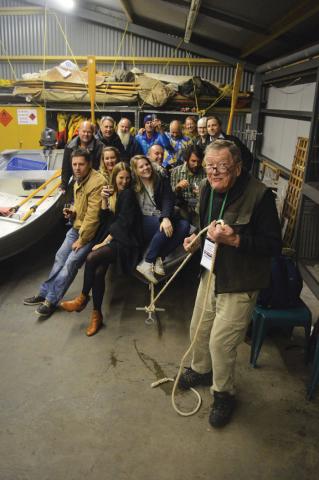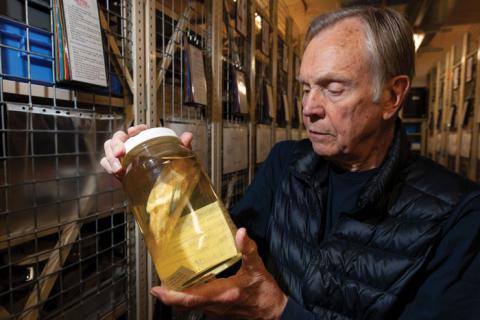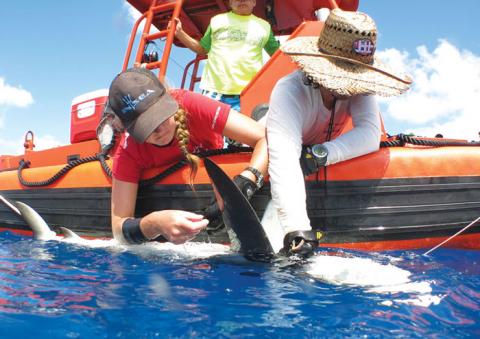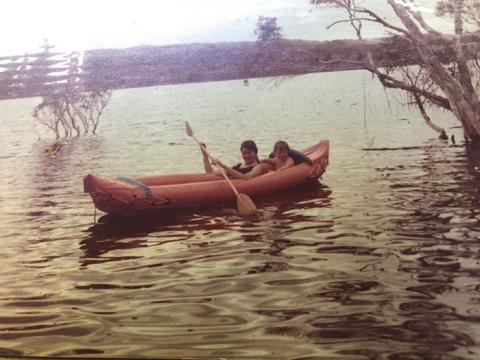The Australian Society for Fish Biology turns 50 this year, with a legacy of hard science and supportive networking that has underpinned the careers of many researchers and progressed the sustainability of Australia’s fisheries
By Melissa Marino
If ever there was a talent incubator for fisheries scientists and managers, the Australian Society for Fish Biology (ASFB) would be it.
Established in 1971, it has surpassed its stated aims to promote the study of fish and fisheries science in Australia and provide a communications medium for those involved.
It has created a vibrant community that gives critical support to its younger members and provides a foothold for careers that go on to have impact and influence in the realms of research and management, policy and practice.
The success of the society lies not just in what it does but how it goes about it. Built into its manifesto from day one was an intent to promote information sharing in an effective and relaxed manner.
At its annual conferences serious science and management findings are presented in an informal, non-hierarchical atmosphere. Conversations in the breaks are considered as important as formalities. Students and early career researchers attend sessions alongside more experienced practitioners and are also honoured with dedicated awards.
It is an approach built on the intellectual capital of diverse regions, fostering synergy across Australian and New Zealand jurisdictions and the intergenerational transfer of knowledge. The conference location also constantly changes; inner Melbourne one year, Darwin, Albany or Hobart the next, which has contributed to connections and collaborations that transcend geographical distance.

ASFB founding member and former president Richard Tilzey, a retired fisheries scientist, pictured here with participants at the 2017 Albany conference encapsulating the convivial nature of society events. Photo: Supplied
A warm welcome
Angela Arthington, now emeritus professor, still remembers the thrill of meeting the “very famous, accomplished” biologist John Lake at her first ASFB conference in the 1970s. Nor has she forgotten the warmth with which she was greeted.
“As a young woman, I was only just starting out in my career and it was such a lovely, casual and happy way to meet people at all levels of their careers and to feel welcome,” she says.
Fast forward 25 years and it was she who became the subject of admiration. In the lunch queue a young Brendan Ebner (now ASFB workshop and conference coordinator) was new to freshwater ecology and feeling “pretty small and insignificant” at his first ASFB conference. Then Arthington struck up a conversation.
“To meet one of those gurus very early on was pretty cool,” he says. “That she gave me the time of day, sat down for lunch and then chatted to me was just really nice. And I’m a pretty chatty person so after that the society never got rid of me.”
Global recognition
Gary Jackson, a 30-year member of the ASFB and a past president, says the society draws esteemed personnel to conferences and into its membership.
There are directors of government agencies, heads of laboratories, and representatives on the world stage, including another past president, Bronwyn Gillanders, who today heads the World Council of Fisheries Societies.
The ASFB represents Australia in this global society composed of 10 member organisations committed to promoting international cooperation in fisheries science, conservation and management.
For young researchers and students to mix with such “heavy hitters” in an informal atmosphere provides valuable mentoring opportunities, Jackson says. And to present their first papers in a consciously supportive environment helps the next generation of leaders to develop.
“At my first conference in 1992, to rub shoulders and talk at the bar with some of these people whose reports I had read built my confidence,” he says.
Today Jackson is a principal fisheries scientist with the Western Australian government, but he has lifelong professional and personal relationships formed with people he met in his earliest ASFB days.
“I get quite emotional when I think about it actually,” he says of the impact of the society on his career. “I don’t think I would be here in a senior position, having done the things I’ve done and been to the places I’ve been without the ASFB and the people I’ve met through it.
“I can pick up a phone and call every fisheries lab in the country and know the person personally and say, ‘here’s an idea’ or ‘do you want to write a funding application’ and vice versa. To put a price on that is impossible.”
Career support
As a world-renowned freshwater ecologist, Angela Arthington’s research on rare and endemic species and fish distribution supported the World Heritage classification of Fraser Island. Her work has helped to protect this and other dune islands from sand mining.
After moving into ecohydrology, her work has informed state policies on dams and provision of environmental flows to sustain fish and other aquatic biota. She now participates in world policy discourse with the International Union for Conservation of Nature (IUCN) and member agencies to reverse the decline of freshwater biodiversity.
Arthington attributes the progression of her career to contacts she made through the ASFB. “As I moved through different fields, I would seek out the experts at ASFB meetings who could help me,” she says. “It was very useful to have a friendly chat that didn’t make you feel intimidated when you’re treading on new territory.”
Because conferences move from state to state – and to New Zealand in the past 10 years – members can tap more deeply into regional knowledge.
As an ASFB workshop and conference coordinator for nine years, Jackson adds that members at host locations also benefit enormously from the experience involved in helping to stage the events, which can involve up to 500 people.
“It teaches people a lot of skills beyond their pure science which are useful in their working lives. You have to communicate, plan, project manage, obtain sponsorships and work within budgets.”

ASFB member Martin Gomon is senior ichthyology curator at Museums Victoria. Photo: Brad Collis
The value of networks
The beauty of meeting your peers annually is discovering exactly what is happening in other jurisdictions says Martin Gomon, senior ichthyology curator at Museums Victoria and a 41-year society member. And this is important for both practitioners and students, he says.
“Doing a degree, it’s very important to know other people working in the same area so you can bounce ideas around and not double up,” he says.
Connections made at the ASFB have also led to members combining their efforts, particularly in field work, which is important in Australia with its limited research resources, he says.
In his own work as a taxonomist classifying fish species, Gomon has been helped by his ASFB contacts to identify and gain access to collections all over the world.
“Although you get it through formal presentations, I often find out who is collecting the material which I’m interested in over a meal and glass of wine,” Gomon says. “It’s actually about developing those networks and they’re often friendships as well.”
Current ASFB president and freshwater ecologist Alison King says the society’s role in facilitating networking not only helps progress careers and collaborative work, but also ensures fish-related issues can be raised, discussed and progressed.
Particular issues are then interrogated through more formal ASFB structures such as the executive council, workshops and committees as well as state-based one-off events and forums.
“National conferences and associated workshops, for example, focus on timely issues in fisheries management and research,” says King.
This occurred at the 2010 conference, where a climate change theme first emerged that spurred journal articles and a focus on the issue in the management of freshwater and marine environments. And in 2020 the issue was highlighted again with ASFB being one of 111 aquatic science societies signing a statement sounding an urgent alarm about the effects of climate change on marine and freshwater ecosystems.
Expert contributions
Back in 1985, Gomon was involved in the society’s first workshop, categorising Australia’s threatened freshwater fish species. That workshop evolved into a dedicated Threatened Fishes Committee.
Each year the committee updates its threatened species list, which is the only comprehensive and continuously maintained record of these species to stretch across a significant time span: 35 years. Using IUCN criteria, the list provides a definitive record of Australia’s threatened fish species and is widely cited in global as well as Australian literature. More than 60 native Australian freshwater fish species are listed as nationally threatened.
University of Canberra freshwater scientist Mark Lintermans has been a member of the ASFB’s Threatened Fishes Committee for 30 years and was its convener for a decade.
“The fact that we have this long-term national overview of how the status of threatened fishes has changed over time is really important,” he says.
In 2020 the committee formed the nucleus of a Commonwealth-funded assessment of the most imperilled fish species in Australia, listing 22 that are likely to become extinct within 20 years. The committee also advised the IUCN assessment of Australian freshwater fish for its ‘Red List’ – the world’s most authoritative record of threatened species.
Of similarly long standing is the Alien Species Committee. It operates as an ‘information exchange’ where jurisdictions share intelligence on introduced species outbreaks or new control techniques for invasive species such as tilapia and carp.
“Committee members come from universities and state fisheries agencies and meetings are open to all ASFB members. So, students can come along and learn about what’s happening in alien fish control or threatened fish management,” says Lintermans, who is also an ASFB ex-president.
The subcommittees provide a continuity of information and a bank of corporate knowledge that is built upon over time, he says. That information is then fed back into agency deliberations, policies and programs. Because the ASFB is a science-based organisation without business or political affiliation, it provides an independent source of knowledge and expertise for governments and industry.
Commercial fishers, aquaculture enterprises and the recreational sector have gained from society activities over the years, with scientists, managers and industry coming together to share their insights and experience, Jackson says.
An annual conference recently covered the topic of stock enhancement and sea ranching and included a “very successful” forum on the conservation of Murray–Darling Basin native fish species, which held particular interest for recreational fishers, he says.
The society also provides an important forum for fisheries managers through its newest committee. The Fisheries Management Committee was created in 2018 to help fisheries managers connect with each other and the broader fisheries community, bridging the gap between management and science across jurisdictions.
Committee chair Patrick Cavalli says it provides collaborative development and and networking opportunities for fisheries managers across Australia and New Zealand. In 2020, in response to COVID-19, the committee instigated virtual workshops focusing on issues and challenges faced by fisheries managers.
The first of these – a series on electronic reporting – was well received by more than 100 managers across the nation who tuned in, Cavalli says. “We are now aiming for quarterly workshops to continue to promote information sharing between fisheries managers and scientists and foster improved policy development,” he says.

Stacy Bierwagen (left) valued her involvement with the ASFB so much as a student researching reef sharks that she is now co-chair of the society’s Education Committee. Photo: Mark Royer
Learning opportunities
Education is the focus of the ASFB’s fourth committee. Dedicated to thinking about the needs of students and how best to meet them, the Education Committee formalises the longstanding commitment of the ASFB to support and encourage young researchers through mentoring and practical measures.
The FRDC has been a long-time supporter of the ASFB, particularly in providing valuable financial support for student awards and to fund student travel for conferences and for research.
“There’s a lot of opportunities if students want to make their research known and get support outside of what their normal institution would be providing,” says Stacy Bierwagen, co-chair of the committee.
As a past recipient of the ASFB’s John Glover Award, funded by the FRDC, she was able to attend conferences and pursue her PhD research into the roles of reef sharks and reef ecosystems.
Bierwagen, now a fish ecologist with the Australian Institute of Marine Science, is using her role with the Education Committee to encourage more students, including undergraduates and school students, to participate.
For example, a video competition in science communication she initiated with Steve Beatty, in conjunction with the Education Committee, lets students take part in conferences even if they cannot personally attend. This competition came into its own at the 2020 conference, which was held online for the first time amid COVID-19 restrictions.
The silver lining of the online-only event was that the conference became accessible to more people who otherwise could not have travelled to it. And it gave the student videos exposure to wide local and international audiences, she says.
Leading by example
As a young researcher, Bierwagen says she has always felt included and empowered at the ASFB. There is a concerted effort within the society to push for gender equity and honour the work of its female members.
Among those honoured in this way is Angela Arthington. In what she considers a “pinnacle” of her career, Arthington was inducted into the ASFB Hall of Fame at its 2016 Hobart conference, which had a specific theme of celebrating women’s achievements.

Freshwater ecologist and ASFB Hall of Famer Angela Arthington took her young son Mark on research assignments in the 1970s, including a North Stradbroke Island fauna survey. Photo: Supplied
This included a “wonderful session” where she was among a number of awardees who spoke about their experiences juggling children with their “adventurous” fishy careers – a challenge with which she was familiar.
“I took my young son over to the sand islands where I was working on the ecology of dune lakes in the late 1970s. There were several children, and we’d give them trays of wet sand and they would pick out all the wriggly things. So we had all of these research assistants, one of whom was two years old.”
Alison King says she wants to build on the society’s track record of inclusivity by providing more opportunities and encouragement for women and diversity – particularly at a senior level. As the society’s third female president, she hopes to provide “a visual” of the possibilities for women.
“People tend to think of those involved in the fishing industry as only men, so just seeing there are women involved across a whole range of areas is important,” she says. “It’s that concept of ‘you can’t be what you can’t see’.”
Leading by example could almost be a motto for the ASFB, whose modus operandi sees the most senior professionals proactively supporting the next generations through the society’s many inclusive activities.
And it is the relationships formed through these activities that ultimately drive diversity and excellence in research and the fisheries sector, says Gary Jackson. “Until you join a society like this, you are not aware that the world can work in these ways,” he says. “It is just priceless.”
Anniversary celebrations
The ASFB’s 50th anniversary celebrations will be held in conjunction with the World Fisheries Congress in Adelaide, from 20 to 24 September. For details of celebration events visit the ASFB.





